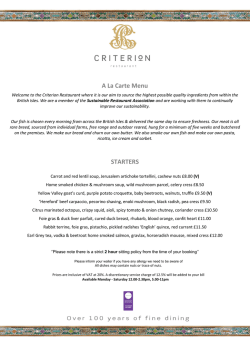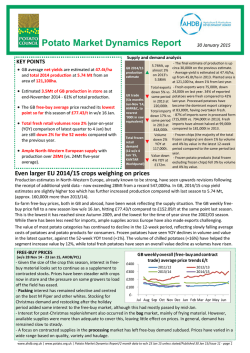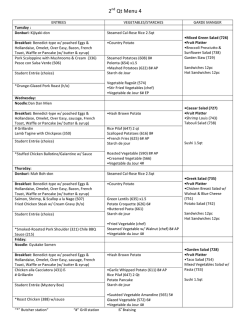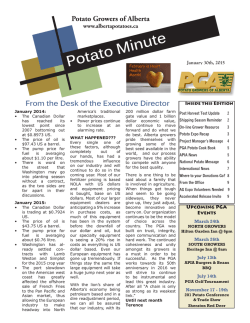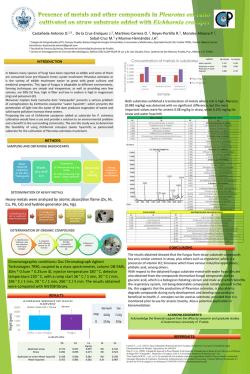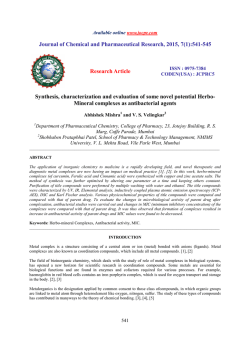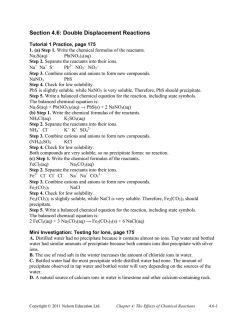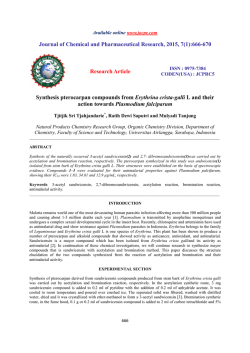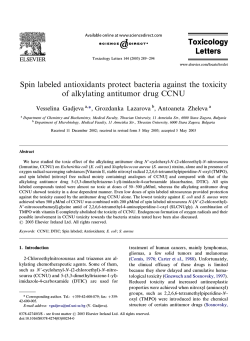
Synthesis and Antitumor Activity of Substituted
International journal of Biomedical science Synthesis and Antitumor Activity of Substituted Succinamides Using a Potato Disc Tumor Induction Assay Farzin Hadizadeh1, 2, Alireza Moradi1, Goli Naghibi1, Mojgan Vojdani1, Javad Behravan1, 2, Mohammad Ramezani1, 2 1 Biotechnology & Pharmaceutical Research Center, Mashhad University of Medical Sciences, Mashhad, Iran; 2 Pharmacy Faculty, Mashhad Univesrsity of Medical Sciences, P.O. Box 91775-1365, Mashhad, Iran Abstract In view of potential biological activities of some succinic acid derivatives, we synthesized some novel N[4-(4-morpholinosulfonyl)-phenyl]-succinamides (6a, c; 7a, c) and N-[4-(benzylaminosulfonyl) phenyl]-succinamides (6b, d; 7b, d) derivatives as antitumor agents. The antitumor activity of compounds was studied using the potato disk bioassay technique (Figure 1). Vincristine at 0.25mg/ml was employed as positive control and caused -67.24% inhibitions. Compound 7b at 1 mg/ml caused -80.50% tumor inhibitions with highest activity among compounds tested. Keywords: succinamides; antitumor; potato disc Introduction Previously dual antitumor and antiinflammatory activity of a series of substituted succinamic acids have been reported (1-4) Synthesis and biological activity of substituted amides and hydrazides of 1, 4-dicarboxylic acids have been recently reviewed (5). In an attempt to find novel succinamides as antitumors, we have synthesized some novel N-[4-(morpholin-4-ylsulfonyl) phenyl] succinamides (6a, c; 7a, c) and N-(4-benzylsulfamoyl-phenyl) succinamides (6b, d; 7b, d). Potato disc is a useful test for monitoring the inhibition of crown-gall tumors (6, 7). Crown gall is a neoplastic disease of plants induced by specific strains of the Gramnegative bacterium Agrobacterium tumefaciens (8), first reported by Smith and Townsend (9) and Jensen (10). This malignancy, normally affecting dicotyledonous plants, is induced by inoculation of a wound site with A. tumefaciens followed by the transfer of a large plasmid from A. tumefaciens to the plant (11). The genetic information (TDNA) of the large plasmid transforms normal plant cells into autonomous tumor cells (12). Once the tumor induction has taken place, the autonomous proliferation of the tumor cells becomes entirely independent of the bacteria (13). Galsky (14) showed that NHCOCH2CH2COOR' RO2S 6a O N N H 6b 6c Corresponding author: Farzin Hadizadeh, Department of Medicinal Chemistry, Faculty of Pharmacy, Mashhad University of Medical Sciences, P.O. Box 91775-1365, Mashhad, Iran. Fax: 98 511 8823251; E-mails: [email protected] or [email protected]. 100 6d O R R' R N N H OCH3 7a OCH3 7b H 7c H 7d O R' N HN S N N H O Figure 1 N HN S HN N N H HN Succinamides as antitumors inhibition of crown gall tumor initiation on potato discs showed good agreement with compounds and plant extracts known to be active in the 3PS (in vivo, mouse leukemia) antitumor assay. In addition to the inhibition of tumor initiation also the inhibition of the growth of the tumors agrees well with 3PS activity (15). Activity of the compounds 6a-d, 7a-d was based on the method described above. Materials and Methods Chemical All the chemicals and reagents were purchased from Merck and Aldrich. 4-acetamidobenzenesulfonyl chloride was synthesized from acetanilide and chlorosulfonic acid according to published procedure. The IR spectra were measured on a Unicam SP-1100 spectrophotometer, using samples prepared as KBr disks. The 1H NMR spectra were recorded on a Brucker AC-80 spectrometer (Germany) operating at a working frequency of 80MHz, using tetramethylsilane as the internal standard. The samples were dissolved in DMSO-d6 or CD3OD. General method for preparation of N-substituted 4-acetamidobenzenesulfonamides (3a, b). To 4-acetamidobenzenesulfonyl chloride (24g, 0.1 mol) dissolved in diethyl ether (300 ml) was added dropwise related amine (0.21 mol). The mixture was stirred at room temperature for 1h. The mixture was poured into ice-water. The precipitate was filtered and dried to give 4-acetamido- N-substituted benzenesulfonamides (3a, b). General method for preparation of 4-amino N-substituted benzenesulfonamides (4a, b). To 4-acetamidoN-substituted benzenesulfonamides (3a, b, 0.08 mol) in water (100 ml) was added concentrated HCl (50 ml). The mixture was heated for 1 h. until a clear solution was obtained. The heating was continued for additional 10 min. The clear solution was cooled to room temperature and neutralized with adding sodium hydroxide (10%) followed by saturated solution of sodium bicarbonate. A precipitate was formed which was filtered and washed with cold water and dried to give 4-amino N-substituted benzenesulfonamides (4a, b). Methyl 3-chlorocarbonylpropionate (5). Succinic anhydride (10g, 0.1 mol) was refluxed in methanol (40 ml) for 8h. The excess methanol was evaporated in vacuum. An oily residue, succinic acid monomethyl ester (13.12 g) was obtained. Thionyl chloride (15 ml) was added dropwiseto the residue during 15 min, while stirring. The mixture was then refluxed for 5 h. Excess thionyl chloride was evaporated in vacuum. The greenish yellow liquid, methyl 3-chlorocarbonylpropionate was used directly in next step without any further purification. N-substituted succinamic esters (6a, b). Compound 5 (4 ml, 0.02 mol) was added dropwise to the stirring solution of compound 4 (0.02 mol) in dry tetrahydrofuran (30 ml) and pyridine (4 ml). Stirring was continued overnight and the solution was evaporated to near dryness in vacuum. Water (20 ml) and a few drops of concentrated HCl were added to the residue to acidify it. The precipitate was filtered and washed with saturated solution of sodium bicarbonate (50 ml) and twice with distilled water (50 ml) to give N-substituted succinamic esters (6a, b). N-substituted succinamic acids (6c, d). To a stirring solution of compound 4 (7.6 mmol) in dry acetone (20 ml), succinic anhydride (0.8 g, 8 mmol) was added and refluxed for 2 h. Acetone was removed with Rota-evaporator. The residue was basified with saturated solution of sodium bicarbonate (10 ml), stirred for 5 min and filtered. The filtrate was acidified with concentrated HCl to pH=2. The precipitate was filtered and then washed twice with distilled water (50 ml). The precipitate was dried to give N-substituted succinamic acids (6c, d). General method for preparation of N, N’-disubstituted succinamides (7a-d). Compounds (6a-d) (10 mmol), ammonium chloride (0.2 g) and suitable amine (10 mmol) were dissolved in tetrahydrofuran (15 ml). The mixture was refluxed for 8 h. The progress of reaction was monitored by thin layer chromatography (TLC). The solvent was removed and the residue was washed with HCl (0.1 N, 50 ml) and cold distilled water (50 ml) to give after dryness N, N’-disubstituted succinamides (7a-d). Screening with the potato disc assay Fresh, disease-free potatoes were obtained from a local market. Tubers of moderate size were surface sterilized by immersion in sodium hypochlorite 0.1% for 20 min. Ends were removed and the potatoes were soaked for an additional 10 min in sodium hypochlorite solution. A core of the tissue was extracted from each tuber with a surface-sterilized 1.0 cm cork borer. Pieces of 2 cm were removed from each end and discarded. The remainder of the cylinder was cut into 0.5 cm discs with a surface-sterilized scalpel. The discs were then transferred to agar plates (1.5 g of agar dissolved in 100 mL double distilled water (DDW), autoclaved for 20 min at 121 °C, 20 mL poured into each Petri dish). Each plate contained 5 discs and 3-5 plates, were used for each sample dilution. 101 Succinamides as antitumors A. tumefaciens (ATCC 23341) was cultivated in Soybean Casein Digest Agar. For inoculation of the potato discs, 48h broth culture containing 5 × 109 cells/ml was used. Samples were dissolved in 5% DMSO, filter sterilized, diluted and mixed with the bacterial culture for inoculation. The potato discs were incubated for 20 days at 25 °C incubator, after which Lugol’s solution (I2/KI) was added, the tumor counts were made and compared with negative controls (bacterial suspension containing 5% DMSO). The results were expressed as + or -percentage versus the number of tumors on the control discs. Significant activity was indicated by consistent negative values of ca. 20% or greater inhibition. Vincristine was used as positive control. Results and Discussion Chemistry Acetanilide (1) was converted to its corresponding sulfonyl chloride (2). Condensation of 2 with related amines (morpholine and benzylamine) gave 4-acetamido-N-substituted benzenesulfonamides (3a, b). Removal of protecting acetyl group afforded N-substituted benzenesulfonamides (4a, b) (Figure 2). Condensation of the N-substituted benzenesulfonamides (4a, b) with succinic anhydride or methyl 3-chlorocarbonylpropionate (5), prepared from succinic anhydride, afforded N-substituted succinamic esters (6a, b) and acids (5c, d). Aminolysis of (6a, b) with corresponding amines (2-aminothizole and benzylamine) gave the succinamides (7a-d) as shown in Figure 3. The synthesized compounds appeared as white crystalline substances stable at room temperature. The compounds were insoluble in water and soluble in DMSO. The proposed structure of compounds was confirmed by IR and 1H NMR spectroscopy. Interpretation of the 1H NMR spectra was base on the chemical shifts, multiplicities, and integral intensities of the signals. The yields and physicochemical properties of compounds 3-7 are presented in table 1. Biological Assay The antitumor activity of compounds was studied using the potato disc bioassay technique. Minimum inhibitory concentration (MIC) of samples on A. tumefaciens was found to be greater than 1 mg/ml. The formation of formazan pink color developed after addition of MTT dye did not give rise to color at lower concentrations of the tested 102 H N H N ClSO3H O O ClO2S 1 2 H N NH2 O RO2 S RO2S 3a,b R= (a) O N 4a,b CH2NH (b) Figure 2 NH2 RO2S CH3OCOCH2CH2COCl 5 or 4a,b NHCOCH2CH2COOR' O O R' R RO2S O 6a O N H 6b 6c 6d OCH3 N O OCH3 H N N H H NHCOCH2CH2CONHR" aminolysis R" R R"NH2 RO2S 7a O N N H 7b 7c 7d N O N S S N N H Figure 3 compounds indicating no inhibition for A. tumefaciens growth. The concentrations above the MIC would produce false positive results in potato disc assay due to the antibacterial activity of the compounds and preventing the bacterium to induce the tumogenesis. Therefore, dilutions below MIC including 0.01, 0.1 and 1 mg/ml were used for potato disc assay. The results have been shown in Table 2. Among these N-Benzyl-N'-(4-benzylsulfamoyl-phenyl)succinamide (7c) and N-Benzyl-N'-[4-(morpholin-4-ylsulfonyl)-phenyl]-succinamide (7d) exhibited significant inhibition of crown gall tumors caused by Agrobacterium tumefaciens at 10 microgram/ml concentration. The activity of compounds 6a, 7b and 7d was comparable to that of vincristine. The results have been shown in Table 2. Vincristine at 0.25 mg/ml was employed as positive control Succinamides as antitumors Table 1 . Physicochemical characteristics of compounds 3-7 compound Yield M.P. oC % (methanol) Empirical formula IR spectrum: νmax, cm-1 CO NH 1H NMR (DMSO-d6) spectrum: δ, ppm 3a 85 103-105 C12H16N2O4S 1690 3350, 3450 10.4(s, 1H, NH), 7.93(m, 4H, arom), 3.73(m, 4H, CH2), 2.9(m, 4H, CH2), 2.1(s, 3H, CH3) 3b 89 129-131 C15H16N2O3S 1680 3300, 3150 10.4(s, 1H, NHCO), 7.9(t, 1H, NHSO2), 7.8(s, 4H, arom), 7.3(s, 5H, arom), 4(d, 2H, CH2), 2.1(s, 3H, CH3) 4a 93 210-212 C10H14N2O3S 1640 3375, 3275 7.9(d, 2H, arom), 7.2(d, 2H, arom), 6.1(s, 2H, NH 2), 3.8(m, 4H, CH2), 2.9(m, 4H, CH2) 4b 89 159-161 C13H14N2O2S 1650 3350,3450,3270 6a 91 138-140 C15H20N2O6S 1720 3350,3250 10.4(s, 1H, aryl-NHCO), 7.7(m, 4H, arom), 3.8 (m, 7H, CH2-morpoline ,OCH3), 2.9(m, 4H, CH2 –morpholine ), 2.6(s, 4H, CH2) 6b 95 150-152 C18H20N2O5S 1725 3350,3250 10.4(s, 1H, aryl-NHCO), 8(t, 1H, NHSO2), 7.6(s, 4H, arom), 7.3(s, 5H, arom), 4(d, 2H, CH 2NHSO2), 3.6(s, 3H, CH3O), 2.6(s, 4H, CH2-succinic) 6c 88 220-221 C14H18N2O6S 1640 3275,3250 10.4(s, 1H, aryl-NHCO), 7.9-7.4(m, 4H, arom), 4-1.9(m, 12H, CH2) 6d 92 169-170 C17H18N2O5S 1640 3260,3250 10.4(s, 1H, aryl-NHCO), 8(t, 1H, NHSO2), 7.6(s, 4H, arom), 7.3(s, 5H, arom), 4(d, 2H, CH 2NHSO2), 2.6(s, 4H, CH2-succinic) 7a 85 160-165 C17H20N4O5S2 1690 3370,3330 9.8(m, 2H, aryl-NHCO), 7.3-6.8(m, 6H, arom, H4,5-thiadiazole), 3.3-2.6(m, 4H, CH2-morpholine) 2.3-1.8(m, 8H, CH2-morpholine, CH2-succinic) 7b 90 170-173 C20H20N4O4S2 1680 3365, 3300 9.8(m, 2H, aryl-NHCO), 7.3(t, 1H, NHSO2), 7.03-6.3(s, 6H, arom, H4,5-thiadiazole), 3.3 (d, 2H, CH2NHCO), 2.8(m, 4H, CH2-succinic) 7c 86 155-157 C21H25N3O4S 1700 3370,3330 10.5(s, 1H, aryl-NHCO), 8.5(m, 2H, NHCO), 7.8(m, 4H, arom), 7.3(s, 5H, arom), 4.3(d, 2H, CH2NHCO), 3.6(4H, CH2-morpholine), 2.9(m, 4H, CH2-morpholine), 2.5(m, 4H, CH2-succinic) 7d 84 170-172 C24H25N3O4S 1650 3290 and caused -67.24% inhibitions. Compound 7b at 1 mg/ml caused -80.50% tumor inhibitions with highest activity among compounds tested. References 1. Burdulene, D.; Palaima, A.; Stumbryavichyute, Z.; Talaikite, Z.; Shimkyavichiene, V. synthesis, anti-inflammatory and antitumor activity of substituted succinamic acids. Pharmaceutical Chemistry Journal, 1999, 33: 125-127 2. Burdulene, D.; Stumbryavichyute, Z.; Talaikite, Z.; Vladyko, G. V.; Boreko, E. I. et al. Synthesis and antiviral activity of N[p-(R-sulfamo yl)phenyl]succinamic acids and their salts with 2-amino-2-thiazoline. Pharmaceutical Chemistry Journal, 1997, 31: 471-473 3. Burdulene, D.; Stumbryavichyute, Z.; Talaikite, Z.; Vladyko, G. V.; 7.4-6.7(m, 12H, arom, NH), 4(s, 2H, CH2) 10.4(s, 1H, aryl-NHCO), 8.5(t, 1H, NHCO), 8(bs, 1H, NHSO2), 7.8(s, 4H, arom), 7.3(s, 5H, arom), 4.3(d, 2H, CH2NHCO), 4(bs, 2H, CH2NHSO2), 2.5(m, 4H, CH2-succinic) Boreko, E. I. et al. Synthesis and antiviral activity of N-aryl- and Nheterylsuccinamic acids and their salts with 2-amino-2-thiazoline. Pharmaceutical Chemistry Journal, 1996, 30: 680-682 4. Burdulene, D.; Stumbryavichyute, Z.; Talaikite, Z.; Penyazeva, G. A.; Buldakova, S. L. et al. Synthesis and analgesic activity of 2-amino2-thiazolinium salts of substituted succinamic acids. Pharmaceutical Chemistry Journal, 1995, 29: 262-264 5. Koz’minykh, V. O. Synthesis and biological activity of substituted amides and hydrazides of 1,4-dicarboxylic acids (a review). Pharmaceutical Chemistry Journal, 2006, 40: 8-17 6. Ferrigni, N. R.; Putman, J. E.; Anderson, B.; B., J. L.; S., M. D. et al. Modification and evaluation of the potato disc assay and antitumor screening of Euphorbiaceae seeds. Journal of Natural Products, 1982, 45: 679-686 7. McLaughlin, J. L. Crown gall tumors in potato discs and brine shrimp lethality: two simple bioassays for higher plant screenings and fractionation in: Hostettmann, K., ed. Methods in plant Biochemistry. 103 Succinamides as antitumors Table 2. Antitumor activity of compounds 6a-d, 7a-d on potato disc model NHCOCH2CH2COR2 R1O2S compound R1 6a O R2 Concentration (mg/ml) Percent growth (±SEM) OCH3 1 -47.5(±7.8) 0.1 -63.17(±4.3) 0.01 -19.76(±4.6) 1 -41.54(±4.3) 0.1 -17.17(±7.6) N 6b OCH3 CH2NH 6c OH O N 6da OH CH2NH 7a N O N HN 7b S N CH2NH HN S 7c O HNH2C N 7d CH2NH a HNH2C vincristine not determined London Academic Press 1991; pp 1-31. 8. Braun, A. C.; Stonier, T. Morphology and physiology of plant tumours. Protoplasmatologia, 1958, 10: 1-93 9. Smith, E. F.; Townsend, C. O. A plant-tumor of bacterial origin. Science, 1907, 25: 671–673 10. Jensen, C. O. Undersøgelser vedrørende nogle svulstlignende dannelser hos planter. Kgl. Veterinaer-Landbohøjskoles. Aarsskrift, 1918, 2: 91–143 11. Watson, B.; Currier, T. C.; Gordon, M. P.; Chilton, M. D.; Nester, E. W. Plasmid required for virulence of Agrobacterium tumefaciens. Journal 104 0.01 -19.24(±4.5) 1 -46.30(±4.5) 0.1 -39.00(±3.7) 0.01 -22.81(±2.4) 1 nda 0.1 nd 0.01 nd 1 -28.37(±5.2) 0.1 -27.76(±9.4) 0.01 -19.72(±9.9) 1 -80.5(±9.3) 0.1 -52.04(±5.1) 0.01 -19.24(±8.7) 1 -39.13(±6.8) 0.1 -37.62(±2.6) 0.01 -35.09(±4.9) 1 -57.44(±2.8) 0.1 -56.17(±6.5) 0.01 -18.84(±1.5) 0.25 -67.24 (±3.8) of Bacteriology, 1975, 123: 255–264 12. Chilton, M. D.; Saiki, R. K.; Yadav, N.; Gordon, M. P.; Quetier, F. T. DNA from Agrobacterium Ti plasmid is in the nuclear DNA fraction of crown gall tumor cells. Proceedings of the National Academy of Sciences USA, 1980, 77: 4060–4064 13. Zaenen, I.; van Larekehe, N.; Teuchy, H.; van Montagu, M.; Schell, J. Sueprcoiled circular DNA in crown-gall inducing Agrobacterium strains. Journal of Molecular Biology, 1974, 86: 109–127 14. Galsky, A. G.; Wilsey, J. P.; Powell, R. G.; . Crown gall tumor disc bioassay. Plant Physiology, 1980, 65: 184–185 Succinamides as antitumors 15. Galsky, A. G.; Kozimor, R.; Piotrowski, D.; Powell, R. G. The crowngall potato disk bioassay as a primary screen for compounds with antitumor activity. Journal of the National Cancer Institute, 1981, 67: 689–692. 105
© Copyright 2024
